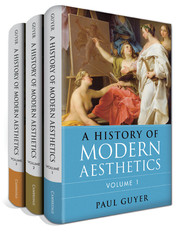Book contents
- Volume 1 The Eighteenth Century
- Volume 2 The Nineteenth Century
- Frontmatter
- Contents
- Acknowledgments
- Introduction
- Part One German Aesthetics in the First Half of the Nineteenth Century
- Part Two (Mostly) British Aesthetics in the Second Half of the Nineteenth Century
- Part Three German Aesthetics in the Second Half of the Nineteenth Century
- Bibliography
- Index
- Volume 3 The Twentieth Century
Part Two - (Mostly) British Aesthetics in the Second Half of the Nineteenth Century
from Volume 2 - The Nineteenth Century
Published online by Cambridge University Press: 05 June 2015
- Volume 1 The Eighteenth Century
- Volume 2 The Nineteenth Century
- Frontmatter
- Contents
- Acknowledgments
- Introduction
- Part One German Aesthetics in the First Half of the Nineteenth Century
- Part Two (Mostly) British Aesthetics in the Second Half of the Nineteenth Century
- Part Three German Aesthetics in the Second Half of the Nineteenth Century
- Bibliography
- Index
- Volume 3 The Twentieth Century
Summary
In Part One of this book, we have seen how the leading aestheticians of German Idealism, Schelling, Schopenhauer, and Hegel, all adopted a cognitivist approach to aesthetics, supposing that the goal of aesthetic experience and particularly of art was to provide insight into the nature of reality, either for its own sake, as in Schelling and Hegel, or as a means to relief from the pain of ordinary life, as in Schopenhauer. We also saw how for Hegel the supposition that art aims at delivering metaphysical truth is its justification but also its own death sentence. We then saw how many of those influenced by these philosophers struggled to escape from the restrictions and consequences of their positions. Schelling’s influence was transmitted to England through Coleridge, but Wordsworth, personally close to Coleridge, Shelley, Emerson in the United States, and even John Stuart Mill, on whom the influence of Coleridge ameliorated the utilitarianism bequeathed to him by Bentham and his own father, sought ways to make room for the emotional impact particularly of art in their own aesthetics. Among German aestheticians after Hegel, there were similar struggles with the confines of his reductive approach to aesthetics, and while Rosenkranz, for example, aimed to broaden Hegel’s approach to the cognitive value of art, Vischer over the course of his long career, devoted almost exclusively to aesthetics, sought to make room for both the Kantian idea of aesthetic experience as the free and harmonious play of our mental powers and the non-Kantian idea of the emotional impact of aesthetic experience of both nature and art. Lotze too sought for at least some common ground between Kantian and Hegelian aesthetics.
- Type
- Chapter
- Information
- A History of Modern Aesthetics , pp. 187 - 190Publisher: Cambridge University PressPrint publication year: 2014



